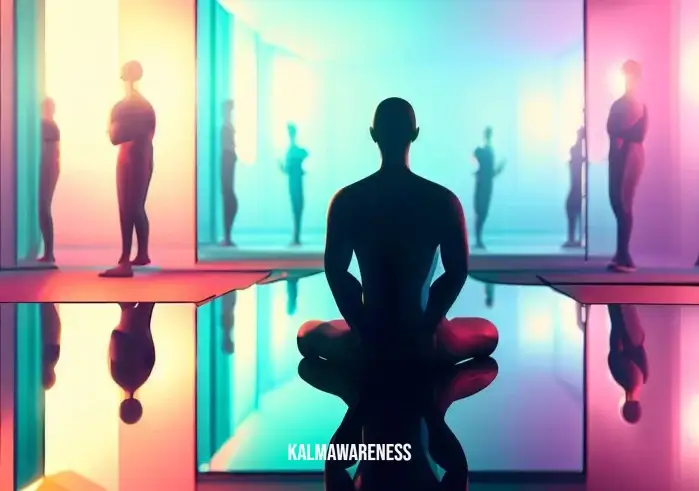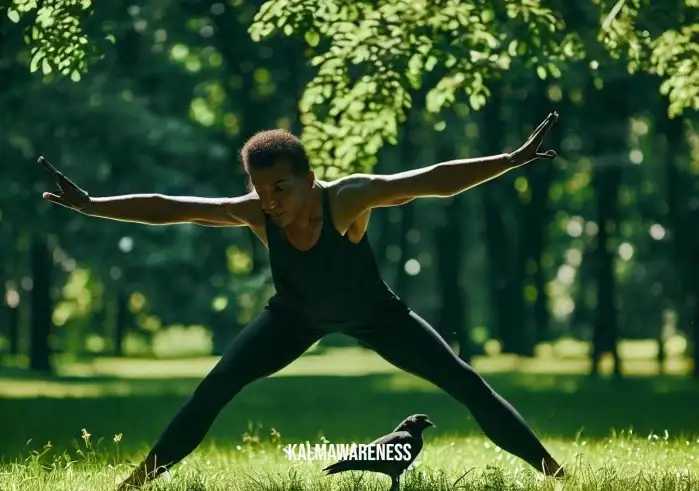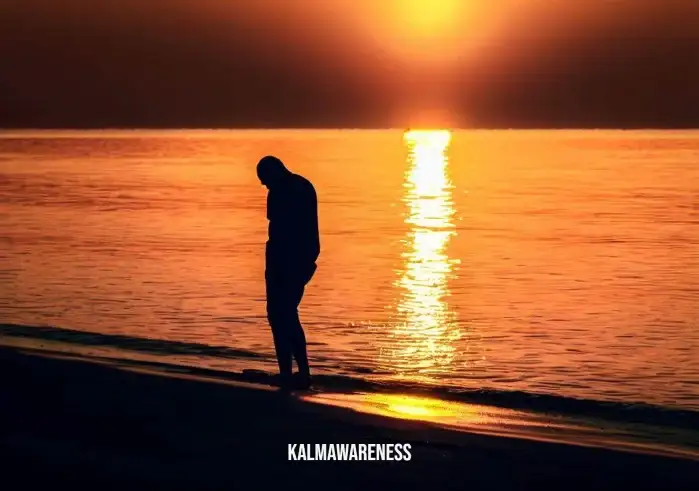Yoga Pose: The Enchanting Crow Pose
| Field | Description |
|---|---|
| Pose Name | Yoga Pose Crow |
| Original Name | Bakasana |
| Difficulty Level | Intermediate |
| Pose Category | Arm Balances |
| Exercise Duration | Beginners: Start with 10-15 seconds, gradually increase to 30 seconds. Advanced: Aim for 1 minute or longer. |
Are you ready to take your yoga practice to new heights? In this article, we’ll explore the captivating and empowering Yoga Pose Crow, also known as Bakasana. This intermediate-level arm balance will not only challenge your physical strength but also cultivate focus and balance. Get ready to spread your wings and soar to new heights of self-discovery.
Step-by-Step Guide
- Prepare your foundation: Begin in a squatting position at the top of your mat. Separate your knees slightly wider than hip-width apart. Place your hands shoulder-width apart on the mat, fingers spread wide, and palms firmly pressed into the ground. Ensure that your fingertips are pointing towards the front edge of your mat.
- Shift your weight: Slowly shift your weight forward, allowing your knees to rest on the backs of your upper arms. Find stability in this position by engaging your core and keeping your gaze focused on a point slightly ahead of you on the mat.
- Engage your core: As you shift your weight forward, lift your feet off the ground, one at a time. Draw your knees towards your chest, hugging them close to your upper arms. Engage your core muscles to maintain balance and stability in the pose.
- Find your balance: With your knees resting on your upper arms and your core engaged, start to lean your weight forward. Gradually shift your weight from your feet to your hands. Feel the connection between your hands and the mat, grounding you and providing stability.
- Extend your legs: As you gain more confidence and stability in the pose, begin to straighten your arms while simultaneously extending your legs backward. Point your toes and engage your leg muscles. Find a balance between the engagement of your core and the extension of your legs.
- Maintain steady breath: As you hold the Crow Pose, remember to maintain a steady and even breath. Deep inhales and exhales will help you find balance and focus, allowing you to stay present in the pose.
- Hold and release: Beginners can start by holding the pose for 10-15 seconds, gradually increasing the duration as strength and balance improve. Advanced practitioners can aim for 1 minute or longer. When you’re ready to release the pose, gently lower your feet back to the mat and return to a squatting position.
Congratulations! You’ve successfully mastered the enchanting Yoga Pose Crow. Remember, this pose requires practice and patience, so be kind to yourself throughout the journey. Embrace the challenges, celebrate your progress, and allow the crow to symbolize the strength and grace within you.

Yoga Pose Crow: Unveiling Its Benefits and Variations
In the enchanting realm of yoga, the Yoga Pose Crow (Bakasana) holds a special place. As we continue our exploration of this empowering arm balance, let’s dive into the numerous benefits it offers, the individuals who may find it challenging, and exciting variations to cater to different levels of experience. Get ready to soar higher and unlock the true potential of the Yoga Pose Crow.
Benefits of Yoga Pose Crow
- Strengthens the Upper Body: As you engage your arms and shoulder girdle to support your body weight, the Crow Pose strengthens and tones the muscles of your arms, wrists, and shoulders. This increased upper body strength can enhance your overall physical performance and stability.
- Core Activation: Balancing on your hands while engaging your core muscles in the Crow Pose not only helps build a strong core but also improves your overall body control and stability. Regular practice of this pose can lead to better posture and enhanced core strength.
- Improved Balance: Crow Pose challenges your balance and coordination, requiring you to find stability on your hands. As you master this pose, you’ll develop a greater sense of body awareness and balance, both physically and mentally.
- Boosts Concentration: Balancing in an arm balance like the Crow Pose requires focus and mental concentration. By centering your attention on the present moment, you enhance your mindfulness and cultivate a deeper mind-body connection.
- Builds Confidence: Successfully mastering the Crow Pose can significantly boost your self-confidence. The accomplishment of balancing your body on your hands and witnessing your progress over time can have a profound impact on your self-esteem and self-belief.
- Stress Relief: Like many yoga poses, the Crow Pose offers stress-relieving benefits. The combination of physical exertion, mindful focus, and deep breathing can help calm the mind, reduce anxiety, and promote overall relaxation.
Who May Find Crow Pose Challenging?
While the Yoga Pose Crow offers a multitude of benefits, it’s essential to recognize that certain individuals may find it more challenging. Here are a few examples:
- Beginners: For individuals new to yoga or arm balances, the Crow Pose may initially seem intimidating due to the required strength, balance, and coordination. However, with consistent practice and patience, beginners can gradually build the necessary skills and confidence to master this pose.
- Wrist or Shoulder Injuries: Those with wrist or shoulder injuries or conditions may need to approach the Crow Pose with caution. It’s crucial to listen to your body and consult with a qualified yoga instructor or healthcare professional to modify the pose or explore alternative options that are safe for your specific needs.
Variations of Crow Pose for Different Levels
To cater to various levels of experience, the Crow Pose offers exciting variations that allow practitioners to progress and explore new challenges. Here are a few variations:
- Crane Pose (Bakasana Variation): In this variation, the knees are positioned higher up on the upper arms, closer to the armpits. This modification provides additional stability and support, making it accessible for beginners or those working on building arm strength.
- One-Legged Crow Pose: As the name suggests, this variation involves lifting one leg off the ground while maintaining balance on the hands. It requires increased core strength and balance, offering an extra challenge for those seeking to deepen their practice.
- Extended Crow Pose: In this variation, the arms are straightened as much as possible, allowing for a deeper stretch and a more extended body position. It requires increased flexibility and upper body strength, making it suitable for more advanced practitioners.
Remember, when practicing variations of the Crow Pose, always prioritize safety, proper alignment, and gradual progression. Listen to your body, respect your limits, and approach each variation mindfully.

Yoga Pose Crow: Unveiling Its History, Spiritual Significance, and Tips for Mastery
As we delve deeper into the captivating world of the Yoga Pose Crow (Bakasana), let’s explore the rich history behind this empowering posture, its spiritual significance, and invaluable tips to enhance your practice. Additionally, we’ll delve into common mistakes to avoid, modifications for individuals with injuries or limited flexibility, and poses that complement the Yoga Pose Crow. Get ready to unlock the hidden treasures within this enchanting pose.
The History of Crow Pose
The origins of the Crow Pose can be traced back to ancient yoga traditions. This pose finds its roots in Hatha Yoga, where it was primarily used as a preparatory pose for more advanced arm balances. Over time, the Crow Pose gained popularity as a symbol of strength, balance, and focus.
The Spiritual Significance of Crow Pose
Beyond its physical benefits, the Crow Pose holds deep spiritual significance. In yoga philosophy, the crow is associated with the manipura chakra, the third energy center located in the solar plexus region. This chakra is linked to personal power, self-confidence, and transformation. By practicing the Crow Pose, you can tap into this energy center and awaken your inner strength and courage.
Tips for Getting the Most Out of Crow Pose
To truly master the Yoga Pose Crow, here are some valuable tips to keep in mind:
- Warm-Up: Prioritize a proper warm-up to prepare your body for the pose. Engage in gentle stretching exercises, particularly focusing on your wrists, arms, and core. This will help prevent injuries and improve your overall stability in the pose.
- Core Activation: Strengthening your core is crucial for a successful Crow Pose. Incorporate core-strengthening exercises into your regular routine to build the necessary stability and support for this challenging arm balance.
- Gradual Progression: As with any yoga pose, progress gradually. Begin by practicing the preparatory exercises, such as squatting and lifting one foot at a time. Gradually work your way up to balancing on your hands with both feet off the ground. Celebrate each milestone and honor your unique journey.
- Focus and Breath: Maintain a steady focus on a fixed point in front of you while practicing the Crow Pose. This helps enhance your balance and concentration. Additionally, focus on deep, steady breaths to calm the mind and cultivate a sense of inner tranquility.
- Patience and Persistence: The Crow Pose may take time to master. Embrace the process and be patient with yourself. Persistence and regular practice will eventually lead to breakthroughs and greater confidence in this empowering pose.
Common Mistakes to Avoid
While practicing the Yoga Pose Crow, it’s essential to be aware of common mistakes that can hinder your progress. Avoid the following pitfalls:
- Collapsing Shoulders: To maintain stability and balance, avoid allowing your shoulders to round or collapse forward. Instead, engage your shoulder blades and keep them actively pressed against your back.
- Gripping the Mat: Excessive gripping or clenching of the mat with your fingers can restrict movement and hinder your ability to find balance. Instead, focus on spreading your fingers wide and evenly distributing your weight through the palms and fingertips.
- Rushing the Process: Trying to rush into the full expression of the Crow Pose without proper preparation can lead to injury or frustration. Respect your body’s limitations and progress at a pace that feels comfortable for you.
Modifications for Individuals with Injuries or Limited Flexibility
The beauty of yoga is its adaptability. If you have injuries or limited flexibility, modifications can be made to allow you to experience the essence of the Crow Pose. Consider the following:
- Supported Crow Pose: Place a block or bolster under your forehead as a support. This modification provides added stability and reduces strain on the wrists and shoulders.
- Using Props: Utilize blocks or blankets under your hands to elevate the ground and decrease the range of motion required in the wrists. This modification can be particularly beneficial for individuals with wrist sensitivity or discomfort.
- Half Crow Pose: Begin by practicing a modified version of the pose, where you balance on one leg while keeping the opposite toes grounded. This allows for increased stability and control while still experiencing the core engagement and balance challenge.
Poses Complementary to Crow Pose
To enhance your yoga practice and support your progression in the Yoga Pose Crow, consider incorporating these complementary poses into your routine:
- Plank Pose: Plank Pose builds core strength and stability, making it an excellent preparatory pose for the Crow Pose. It strengthens the arms, wrists, and abdominal muscles, providing a solid foundation for advanced arm balances.
- Chaturanga Dandasana: This pose helps strengthen the arms, shoulders, and core while also refining the engagement of the entire body. Practicing Chaturanga Dandasana with proper alignment and control will contribute to your overall strength and stability in the Crow Pose.
- Revolved Chair Pose: Revolved Chair Pose improves balance, strengthens the legs, and engages the core muscles. It also helps cultivate focus and concentration, qualities that are invaluable in mastering the Crow Pose.




